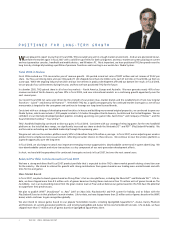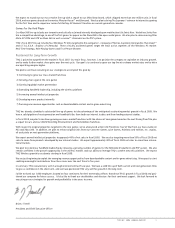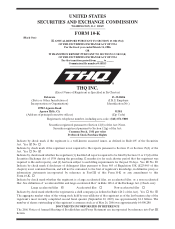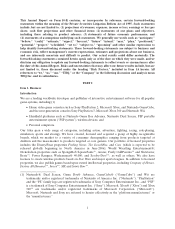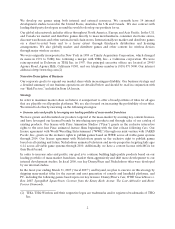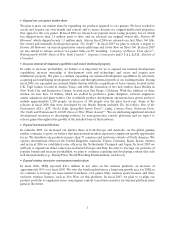THQ 2006 Annual Report Download - page 14
Download and view the complete annual report
Please find page 14 of the 2006 THQ annual report below. You can navigate through the pages in the report by either clicking on the pages listed below, or by using the keyword search tool below to find specific information within the annual report.6
additional platform licenses and extend current licenses as new platforms are launched or our current
agreements expire.
The platform licenses are not exclusive and require that each title be approved by the manufacturer prior
to development of the software, and once developed, manufactured solely by such manufacturer or a
designated vendor of the manufacturer. The licenses establish the fees that we must pay to the
manufacturer for each cartridge or disc made. Nintendo charges us a fixed amount for each Game Boy
Advance cartridge manufactured. This amount varies based, in part, on the memory capacity of the
cartridge. Our Nintendo, Sony and Microsoft console agreements include a charge for every disc
manufactured. The amounts charged by the manufacturers for both console discs and handheld cartridges
include a manufacturing, printing and packaging fee as well as a royalty for the use of the manufacturer’s
name, proprietary information and technology, and are subject to adjustment by the manufacturers at their
discretion. The manufacturers have the right to review, evaluate and approve a prototype of each title and
the title’s packaging.
In addition, we must indemnify the manufacturers with respect to all loss, liability and expense resulting
from any claim against the manufacturer involving the development, marketing, sale, or use of our games,
including any claims for copyright or trademark infringement brought against the manufacturer. As a
result, we bear a risk that the properties upon which the titles are based, or that the information and
technology licensed from others and incorporated in the products, may infringe the rights of third parties.
Conversely, our agreements with our third-party software developers and property licensors typically
provide for us to be indemnified with respect to certain matters. If any claim is brought by a manufacturer
against us for indemnification, however, our developers or licensors may not have sufficient resources to,
in turn, indemnify us. Furthermore, these parties’ indemnification of us may not cover the matter that gives
rise to the manufacturer’s claim.
Each platform license may be terminated by the manufacturer if a breach or default by us is not cured after
we receive written notice from the manufacturer, or ifwe become insolvent. Upon termination of a
platform license for any reason other than our breach or default, we have a limited period of time to sell
any existing product inventory remaining as of the date of termination. The length of this sell-off period
varies between 90 and 180 days, depending upon the platform agreement. We must destroy any such
inventory remaining after the end of the sell-off period. Upon termination as a result of our breach or
default, we must destroy any remaining inventory.
Product Development
We develop our products using both internal and external development resources. The internal resources
consist of producers, game designers, software engineers, artists, animators and game testers located within
our 14 internal studios and corporate headquarters. The external development resources consist of third-
party software developers and other independent resources such as artists. We refer to this collective group
of development resources as our Studio System.
We make the decision as to which development resources to use based upon the creative and technical
challenges of the product, whether the intellectual property which is being developed into a game is
licensed, an original concept that we created, or an original conceptcreated by a third-party developer.
Once we determine where a product will be developed, our internal product development team oversees
the internal or external resources in its design, technical assessment and construction of each game.
The development cycle for a new game depends on the platform and the complexity of the game.
Additionally, when developing an intellectual property into a game which is simultaneously being made
into a motion picture, our development schedule is designed to ensure that our games are commercially
available by the motion picture’s release. The development cycle for games on current generation console
platforms, PC games and the Sony PSP system generally ranges from 12 to 24 months, Game Boy Advance


